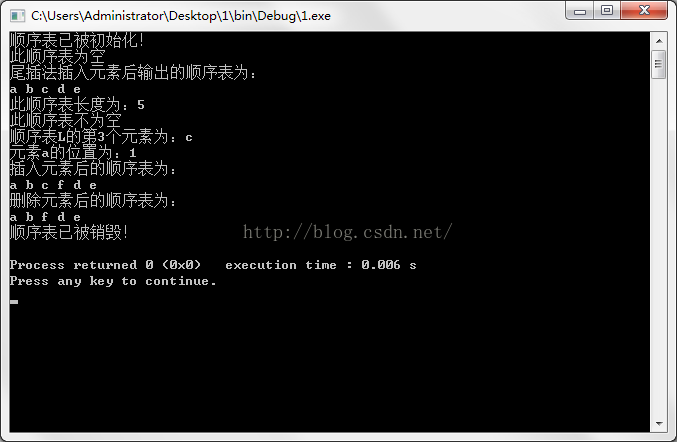数据结构第2章上机实验题2.1
问题描述:实现顺序表的基本运算(1-12具体要求见课本P62),作为对已经学过的顺序表的小revision~
源代码:
list.h:
#include
#include
#define max 100
typedef char Elemtype;
typedef struct list
{
char data[max];
int length;
} Sqlist;
void Initlist(Sqlist *&l);
void Createlist(Sqlist *&l,Elemtype a[],int n);
void Displist(Sqlist *l);
int Listlength(Sqlist *l);
bool Listempty(Sqlist *l);
void Dispelement(Sqlist *l,int loc);
void Disploc(Sqlist *l,Elemtype e);
bool Insertelement(Sqlist *&l,int loc,Elemtype e);
bool Deleteelement(Sqlist *&l,int loc,Elemtype &e);
void Destroylist(Sqlist *&l); fun.cpp:
#include
#include "list.h"
void Initlist(Sqlist *&l)
{
l=(Sqlist *)malloc(sizeof(Sqlist));
l->length=0;
}
void Createlist(Sqlist *&l,Elemtype a[],int n)
{
int i;
l=(Sqlist *)malloc(sizeof(Sqlist));
for(i=n-1;i>=0;i--)
l->data[i]=a[i];
l->length=n;
}
void Displist(Sqlist *l)
{
int i;
for(i=0;ilength-1;i++)
printf("%c ",l->data[i]);
printf("%c\n",l->data[l->length-1]);
}
void Dispelement(Sqlist *l,int loc)
{
int i;
for(i=0;ilength;i++)
{
if(i==loc-1)
printf("%c\n",l->data[i]);
}
}
void Disploc(Sqlist *l,Elemtype e)
{
int i;
int flag=0; //判断是否找到,flag=1找到,flag=0未找到
for(i=0;ilength;i++)
{
if(l->data[i]==e)
{
flag++;
printf("%d\n",i+1);
}
}
if(flag==0)
printf("未找到该元素\n");
}
int Listlength(Sqlist *l)
{
return (l->length);
}
bool Listempty(Sqlist *l)
{
if(l->length!=0)
return true;
else
return false;
}
bool Insertelement(Sqlist *&l,int loc,Elemtype e)
{
int i;
if(loc<1 || loc>l->length+1 || l->length==max)
return false;
loc--;
for(i=l->length;i>loc;i--)
l->data[i]=l->data[i-1];
l->data[loc]=e;
l->length++;
return true;
}
bool Deleteelement(Sqlist *&l,int loc,Elemtype &e)
{
int i;
if(loc<1 || loc>l->length+1)
return false;
loc--;
e=l->data[loc];
for(i=loc;ilength-1;i++)
l->data[i]=l->data[i+1];
l->length--;
return true;
}
void Destroylist(Sqlist *&l)
{
free(l);
} main.cpp:
#include
#include "list.h"
int main()
{
Sqlist *l;
Elemtype a[5]={'a','b','c','d','e'}; //5个元素a,b,c,d,e
Elemtype e;
Initlist(l); //初始化顺序表L
printf("顺序表已被初始化!\n");
if(Listempty(l)) //判断顺序表L是否为空
printf("此顺序表不为空\n");
else
printf("此顺序表为空\n");
Createlist(l,a,5); //尾插法依次插入a,b,c,d,e
printf("尾插法插入元素后输出的顺序表为:\n");
Displist(l); //输出顺序表L
printf("此顺序表长度为:");
printf("%d\n",Listlength(l)); //输出顺序表L长度
if(Listempty(l)) //判断顺序表L是否为空
printf("此顺序表不为空\n");
else
printf("此顺序表为空\n");
printf("顺序表L的第3个元素为:");
Dispelement(l,3);
printf("元素a的位置为:");
Disploc(l,'a');
Insertelement(l,4,'f'); //在第4个元素位置上插入元素f
printf("插入元素后的顺序表为:\n");
Displist(l); //输出顺序表L
Deleteelement(l,3,e); //删除L的第3个元素
printf("删除元素后的顺序表为:\n");
Displist(l); //输出顺序表L
Destroylist(l); //释放顺序表L
printf("顺序表已被销毁!\n");
return 0;
} 运行结果:
